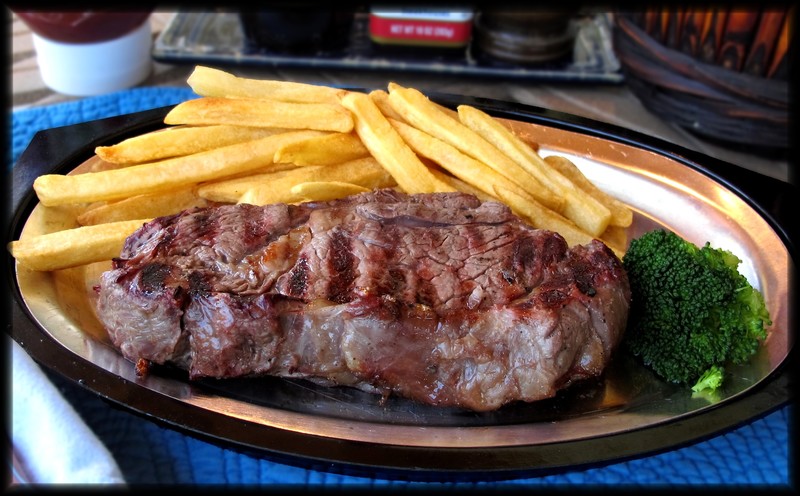If you’ve been reading this column over the past few weeks, you may have noticed we’ve been on a search for new and different proteins to enliven our dinner menus. From Colorado lamb to plump duck breast to custom smoked sausages, Hickman’s Meat Market is where we’ve found many unique entrée inspirations. On our most recent visit, we discovered there’s far more to bison than burgers.
The first question to answer is: What’s the difference between bison and buffalo? The huge animals roaming this continent in great numbers when our ancestors arrived are sometimes called American buffalo; these are in fact bison. Cape buffalo of Africa and water buffalo of Southeast Asia are species unrelated to the bison and are considered true buffalo. A bison has a thick coat, shaggy beard and noticeable hump; a buffalo has longer horns and a short, glossy coat. While bison were hunted to near extinction, buffalo were domesticated (think plow animals and buffalo mozzarella).
Bison are once again ranging the prairies as farmers raise herds to meet a surging demand from health-conscious consumers. Bison spend their days grazing grass and aren’t subjected to hormones or chemicals to boost their growth; their meat is low in fat and cholesterol and free of additives. Bison meat is deep red in color, without the fatty streaks (marbling) seen in beef. If you love the rich, clean flavor of grass-fed beef, you’ll certainly enjoy the taste of bison.
While most recipes that call for beef can be made with bison, there are a few key differences to remember. Bison aficionados argue there’s no such thing as bad bison meat, only badly cooked bison meat (criticizing the cooks – imagine that). Without fat as insulation from the heat, bison cooks quite quickly, as much as 40 percent faster than beef. Hence the best approach is slow and low: slow cooking at a lower heat. Since there’s no fat melting from the meat, you may need to oil the pan or grill to prevent sticking.
One feature of bison that may surprise you the first time you see it served is that bison keeps its bright-red color even after it’s cooked. When grilled to medium, as in the photo, bison will appear to be very rare. Be sure to check for doneness early and use a meat thermometer for accuracy. Also, the internal temperature will keep rising once the meat is removed from the heat, so take it out of the pan soon enough to give the meat a chance reach the desired degree of doneness while it rests.
Ground bison meat shows up quite often in the local supermarkets, and you may see recipes calling for a mixture of bison and beef (or pork) for burgers. This seems to defeat the health purposes of choosing bison and will mask the pure, clean flavor of pure bison meat. There is very little shrinkage in cooking ground bison meat; the size of the raw burger will be close to the finished product. Once again, slow and low is key to avoiding shoe-leather texture or the proverbial hockey puck. If you’re grilling, set the temperature at medium to keep the exterior from scorching while the interior remains raw.
When we planned our bison rib eye dinner, we turned to Bill Hickman for advice as he trimmed two glistening, ruby-colored steaks. He was uncharacteristically vague about how to season the steaks (not too much, definitely no salt, maybe some garlic powder), and extremely detailed in the cooking instructions. Cook one minute on each side over a very high heat, then move them off the direct heat and give them four minutes per side. We followed his process to the letter and the outcome astonished our taste buds – juicy, tender, rich and meaty – what amazing flavor.
Now that we’ve tried some less-than-ordinary meat and poultry (ostrich was my least favorite), I’m ready to go back to my old favorites for a while – or perhaps try something vegetarian.
Bison Rib Eye
2 bison rib eye steaksolive oil
garlic or onion powder
black pepper
Rub olive oil across both sides of the steak, sprinkle with seasonings. Brush the grate with vegetable oil or nonstick cooking spray. Preheat the grill to high for at least 10 minutes before cooking. Place the steaks over the direct flame and cook for one minute on each side. Reduce the temperature to medium and move the steaks away from the direct heat. Cook another four minutes on each side. Place the steaks on a platter, loosely covered with foil and allow to rest for about 10 minutes before serving. Yield: 2 servings.
Basic Bison Burgers
2 lbs ground bison
1 t sea salt
1/2 t pepper
canola oil
Gently spread out the meat on a piece of waxed paper. Dust with salt and pepper. Form the seasoned meat into 6 patties. Place on a platter, cover with plastic wrap and refrigerate for an hour. Brush the grate with oil to coat; preheat the barbecue grill to high. Lightly brush one side of each patty with canola oil. Place the burgers on the grill, oil side down, and close the lid. After 4 minutes, turn the burgers, close the lid and cook for another 3 minutes. Reduce the heat and turn the burgers once more. After another 4 minutes check their internal temperature. When the thermometer reads between 135 F and 140 F, remove burgers to a platter and allow them to rest for 5 to 10 minutes before serving.
Basic Bison Pot Pie
2 lbs cubed bison round steak
2 T bacon drippings
2 C onions, chopped
1 t salt
1/2 t pepper
1/2 t thyme
1 bay leaf
2 t Worcestershire sauce
1 1/2 C beef stock
3 C diced potatoes
1 C diced carrots
2 T butter
3 T flour
1/3 C stock
1 pastry crust
Melt the bacon drippings in a large, deep skillet. Stir in bison and cook over medium until lightly browned. Add onions, salt, pepper, thyme and bay leaf. Cook until onions become translucent. Deglaze the pan with stock, scraping up any browned bits from the bottom. Simmer over very low heat for 1 1/2 hours. Stir in potatoes and carrots; simmer for 1/2 hour. In a small pan, make a deep golden roux with the butter and flour. Stir in 1/3 C stock and add the slurry to the skillet, stirring until sauce is thickened. Preheat oven to 425 F. Coat the inside of a 3-quart casserole dish with nonstick cooking spray. Pour the meat and vegetable mixture into the casserole; cover with pastry and flute the edges. Cut 3 slits in the center and bake until lightly browned, about 20 minutes. Yield: 6 servings.























































